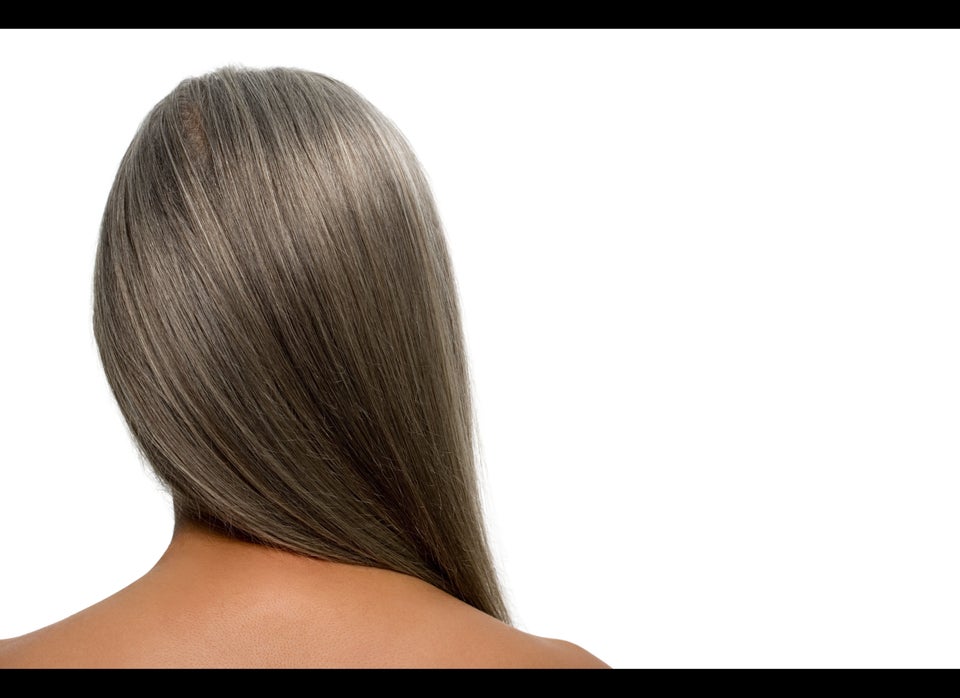The aesthetics of women’s aging have always mattered in a way that men’s just haven’t.
We see it in our thirsty endorsement of silver foxes Anderson Cooper and Steve Carell, which sharply contrasts to the public shaming of Kate Middleton’s errant grays, or the demeaning way the press treated Alexandra Grant, the silver-haired artist who was speculated to be dating (the much older) Keanu Reeves. We see it in the self-deprecating tone of TV host Kelly Ripa’s “roots watch” during the ongoing COVID-19 lockdown, an experience so universally female that “grooming deficit” social isolation memes are now a thing.
In films and on TV, ageist casting is rife ― silver-haired women are either gummy grannies or washed-out women set up for a second sexual wind. Increasingly, they are villains like Narcissa Malfoy (Helen McCrory in the Harry Potter movies) and Alma Coin (Julianne Moore in ”The Hunger Games”), their hair visual affirmation of their frosty, amoral personas and dysfunctional inner lives. Occasionally they are flat, sexless, oracular or quasi-authority figures like M (Dame Judi Dench in the James Bond films) and Nova Prime (Glenn Close in “Guardians of the Galaxy”), placed firmly outside the humanizing influences of family and friendships and defined exclusively by their solitariness.
In real life, white-haired icons are few and far between: Queen Elizabeth II with her prim, fluffy nimbus of a hairdo; Christine Lagarde’s textbook French chicness; and politician Theresa May, whose hair has had to compensate for her lively sartorial style to be declared suitably prime ministerial.
Gray hair has had several “moments” recently, like when Kim Kardashian, Rihanna and Lady Gaga went silver, and when young South Koreans flooded Instagram with unexpectedly flattering pastel-tinted styles. It felt revelatory, but also costumey: For those who struggle with ageist comments and policies at work, the trend felt especially cruel.
Newer imagery feels like a definite improvement: Salma Hayek’s lush pewter look in “The Hummingbird Project” and Nicole Kidman’s silver seaweed-hair cascading down her warrior’s exoskeleton in “Aquaman” are good examples. Women are showing us that attitudinally, the severe “power gray” isn’t the only way to wear silver hair.
We interviewed eight women who shared what it means to lean into their gray hair right now.
Anuja Chauhan, author, columnist and screenplay writer, India
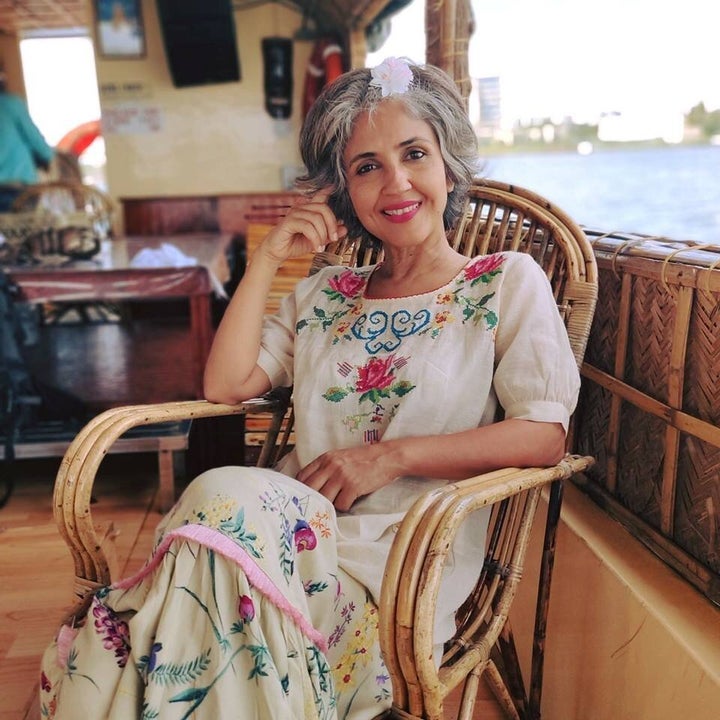
Life gets so much better as you get older. You become less eager to please, more unapologetic, you gain perspective and lose uptightness, you figure out how you like your drinks, your promotions, your orgasms, your boundaries and your balance of life. It’s all great!
I got really excited when the first silvers showed. I liked how they looked ― like natural highlights! My mother had a glorious head of silver hair herself and didn’t want me to quit coloring. She’d always say, “Wait for me to die at least!” There’s a right time for everyone, and at my mum’s funeral, I felt my time had come. I felt older, more mature, and ready to bare my so-called flaws to the world without giving a damn. I’ve been dye-free since August 2016. I’d been wanting to do it for a while ― the sheer drudgery of the process got to me, also hiding the gray made me feel fake and slightly desperate.
There are two perceptions about silver hair in India. 1. It will make you look old. 2. It will make you look dark. Being a dark, old woman is pretty low on the totem pole in Indian society, but I love that there’s a tribe of ladies who are proving that one can still be powerful, relevant, sexually active and gorgeous while being an “old, dark woman.”
Right now I’m enjoying how healthy my hair feels. Being gray makes me feel super smug and virtuous. Also, I’m blunt and a little obnoxious, and I find people take obnoxiousness from gray-haired people better than they take it from people with colored hair. I love sticking flowers in my hair ― they stand out so well against the gray!
I’d like to see more excitement around silver hair! More styles, rinses, lowlights, streaks. Stuff that celebrates the arrival of our grays, the way the arrival of our breasts was celebrated all those years ago.
April Showers, actor, model, hairstylist and burlesque dancer, United States
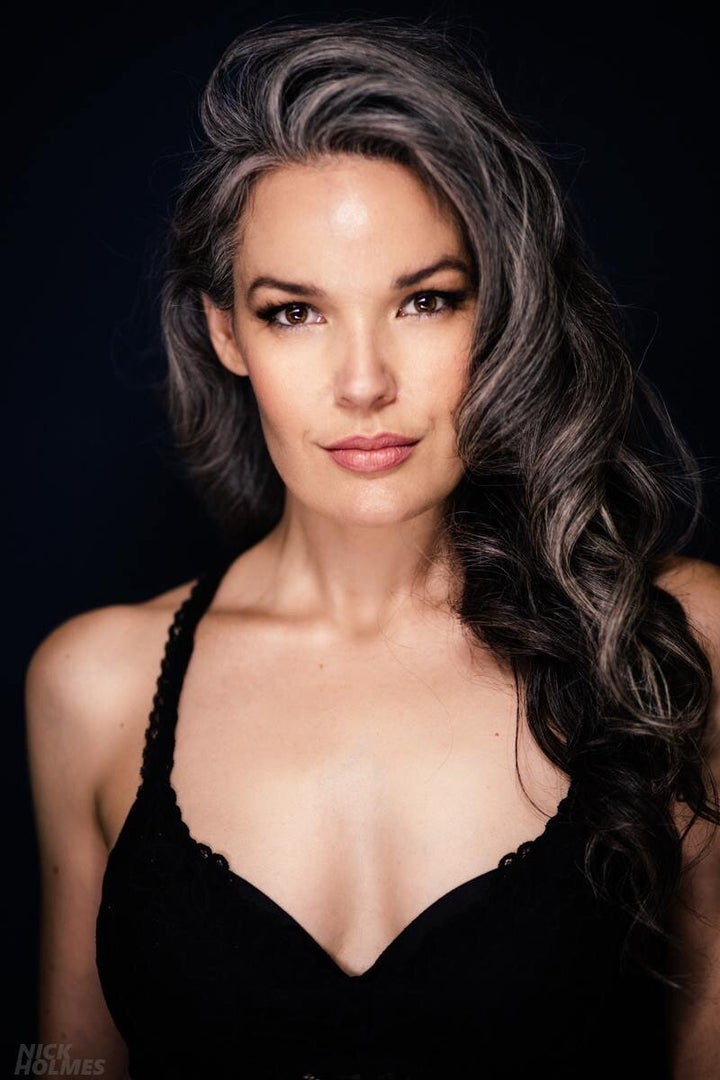
I got my first silvers when I was 18 and in beauty school. I was surprised! I instantly colored my entire head. At that time, the teachers at my school said I had to “do something about those grays.” Once, my boss at the salon told me that people wouldn’t want their hair done by me because of my hair. He believed that if graying women won’t color, they should just cut it all off, wear overalls and go live on a farm. That broke my heart.
Now, I’m loving everything about my hair! It’s the healthiest it’s ever been. It kind of changes color depending on the light I’m in. It’s strong and sparkly and it got me on billboards all over Europe and the U.K. last year! So, yeah, I’d say I love my hair.
In my business, many older women who are naturally gray but color it assume that I color my hair this way. They have even said, “Well, you might like that now, but wait until you’re my age and it starts coming in natural.” I tell them, “This is natural.” And it’s always the same ― wide eyes, open mouths. They are stunned. It’s kind of funny! If my clients tell me they’re ready to embrace their gray, I fully support them. Even though color services are big money, I want them to trust that I do what I do to make them feel happy and beautiful. I want to see this in all salons. It’s getting better but there is still a lot of work to be done.
Lolly Streek, business owner, model and actor, England
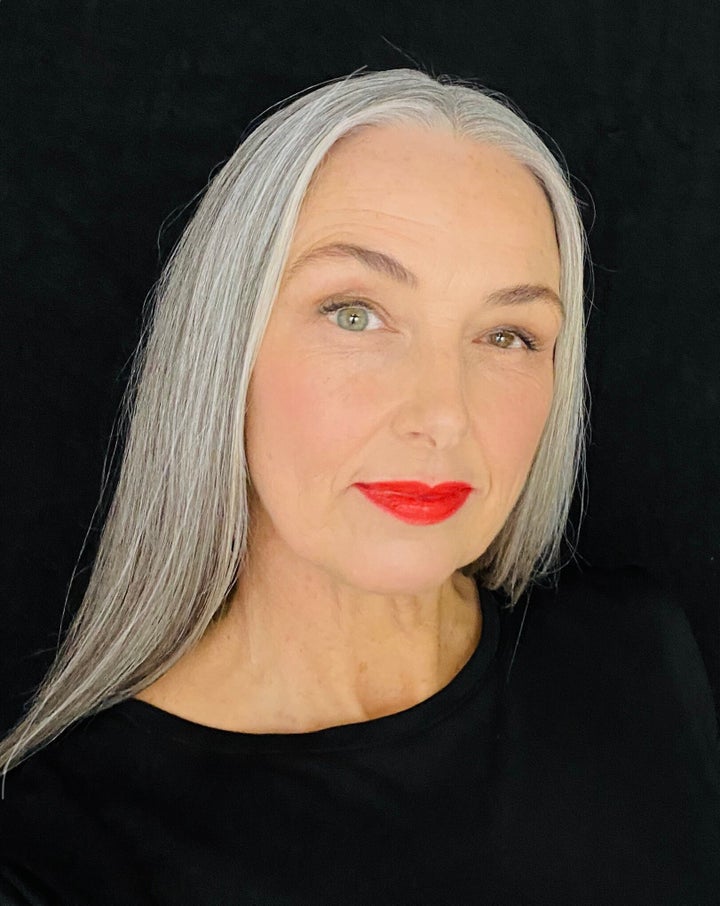
When I first started to go gray in my early 30s, my hair was dark brown. The gray came through just as a silver streak at the front, so I continued to use semi colors on the rest of my dark hair to keep the depth, but leave the streak to stay silver. Around 15 years ago, it started to become more gray through the rest of the hair. I was never interested in dyeing it and just let it come on through naturally. My dad had the most beautiful startling white hair, which I always admired, but I knew it was going to be harder for a woman to be accepted as having gray hair especially at a young age.
Now that it’s more silver than not, my hair has really come into its own. It has always been quite fine and, since going gray, it seems to have a better weight and strength to it. I ignore the old adage that women over 50 shouldn’t have long hair, so I enjoy twisting and plaiting my hair and adding flowers, which look great against the silver. I’ve also found that I can pull off a classic look better, and for the first time in my life, rock a red lipstick. I see strength in my hair’s silver, rather than the weakness usually associated with gray hair.
People absolutely should dye their hair whatever color they choose, should they choose, but so many adverts push women to think that the gray is wrong and needs covering up. When I was younger, it was much harder to make the decision ― no one else had gray hair. I also have a blind eye and occasionally use a walking stick; because all these are stereotypical representations of what old/weak looks like, I like to fight them and rock my own individual look. I’ve recently been signed on by a talent agency, and a big part of that was the new trend for gray models/actors, which was a great moment. I’ve also had someone come up to me on a crowded dance floor to say that she was inspired to ditch the dye and now herself had beautiful silver hair.
Lashawnda Becoats, lifestyle magazine editor, life coach and model, United States
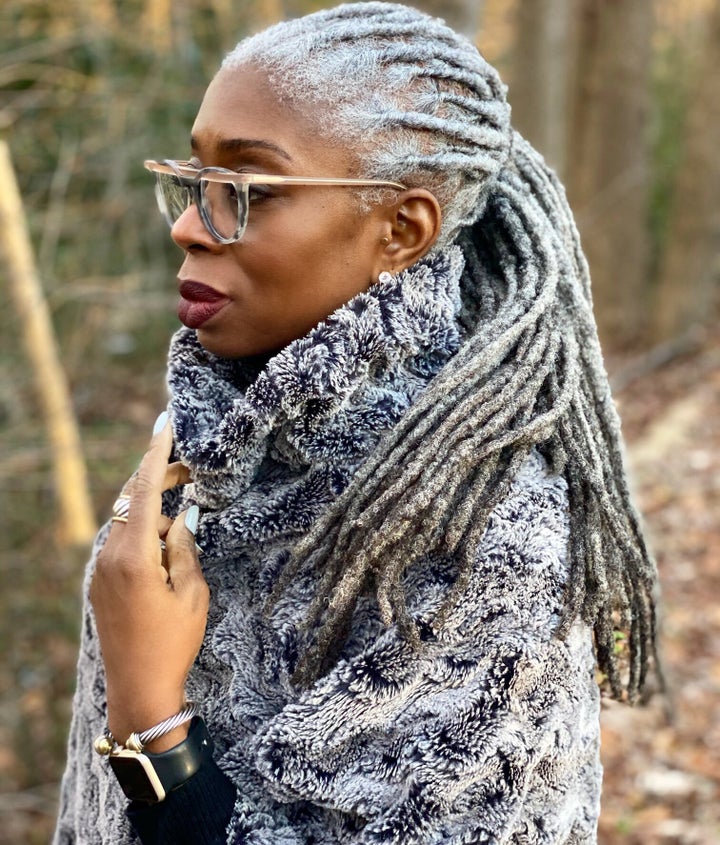
I was 18 when I first started graying. I remember my hair stylist joking back then saying I needed to get rid of the grays because I was too young to have gray hair, so that’s when I started getting it colored. I think that’s the first negative messaging I received around the idea that gray/silver tresses weren’t an acceptable beauty standard. I stopped coloring my hair nine years ago and funnily enough, it all started with a trip I took to Europe for my 40th birthday. While I was away for two weeks, my gray strands started coming in (I had my hair colored before I left) and I liked what I saw in the mirror. I felt different. When I returned to the States, I told my stylist not to color my hair anymore. She protested, so I got rid of her and started my journey to gray hair.
I got scouted for my first professional modeling gig in New York because of my hair. I cried because I couldn’t believe that something that made me feel so uneasy initially was now something to be celebrated and embraced. Today I’m loving the freedom of wearing my natural gray locs. Without saying a word, I think my hair says I’m a woman who embraces who she is and doesn’t conform to societal standards of beauty.
I was a mess when I started going through the transition because I got so much flak from friends, family and strangers. “Why are you doing this?” they said or “I could never!” was all I heard. There were days when I wanted to run back to hair color and give up. I’m glad I didn’t. The transition process made me stronger and more secure about myself. I learned that how I felt and what I thought of myself was more important than what other people thought of me. It has been one of the greatest lessons of my life.
A Black woman’s hair is her crown and glory and we express ourselves through our hairstyles and hair color. I love that in my culture gray hair is being embraced more now because the color is being seen as “cool” and isn’t associated as much with age or beauty. A lot of younger women are getting gray weaves and braids and coloring their hair gray. I love it! People ask me often what hair dye I use to get my hair color. I just laugh and say “genes.”
Sandrine, teacher, France
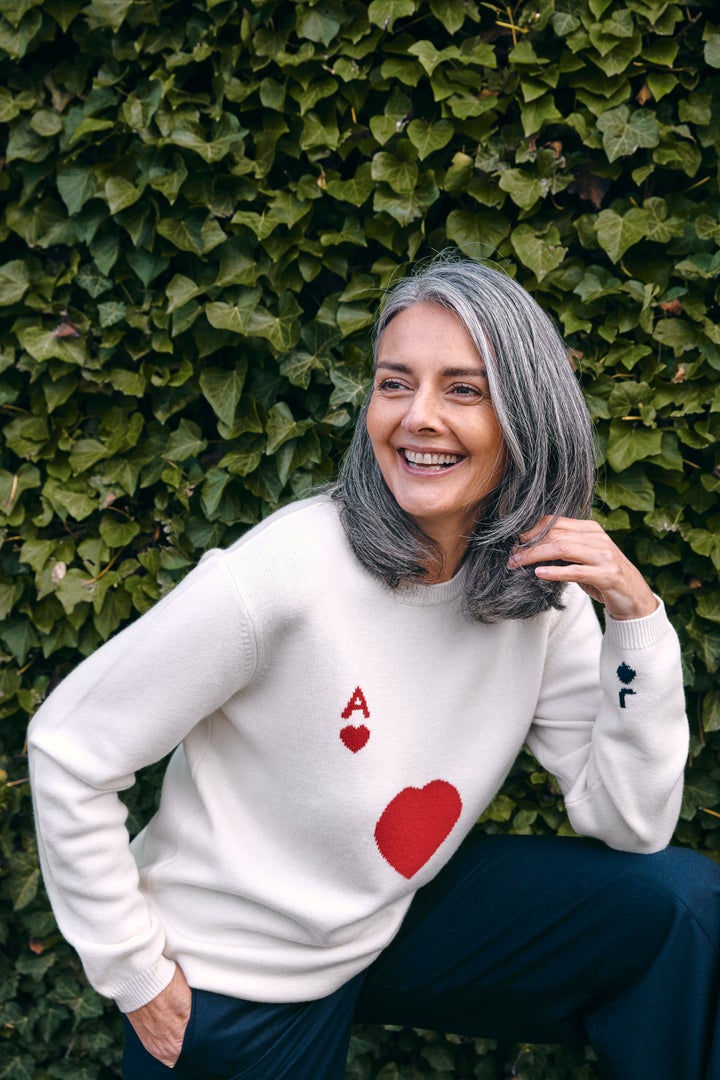
I had been dyeing my hair for 30 years when I first decided to stop. I cut my hair off in 2012 in an attempt to let my gray hair grow out, but I wasn’t quite ready. When my son said I was too young to be gray, I went back to the salon. I finally ditched the dye at 48 after spending three hours in the hairdresser’s chair to be gray-free for the holidays, because I wanted to be as sexy and confident as the ladies I admired on Instagram. Today my hair is thick, healthy and makes me feel so much more free and feminine.
In France, women really pay attention to how they look. They tend to become invisible once they hit 50 or start to go gray. I remember writing a post about it saying I would prove people wrong. I have modeled for clothing brand Soi Paris and lingerie makers Pomm’Poire and Le Slip Français. I often feel like a pioneer but things are slowly changing as more and more French women let their grays out. I secretly hope I inspire them as I was inspired.
I believe that if the media showed more women with gray hair, it would be easier for women to embrace their grays. Why would you have a lady or man with gray hair promote only hearing aids or funeral conventions?
Carla Martin, graphic designer and homemaker, Mexico
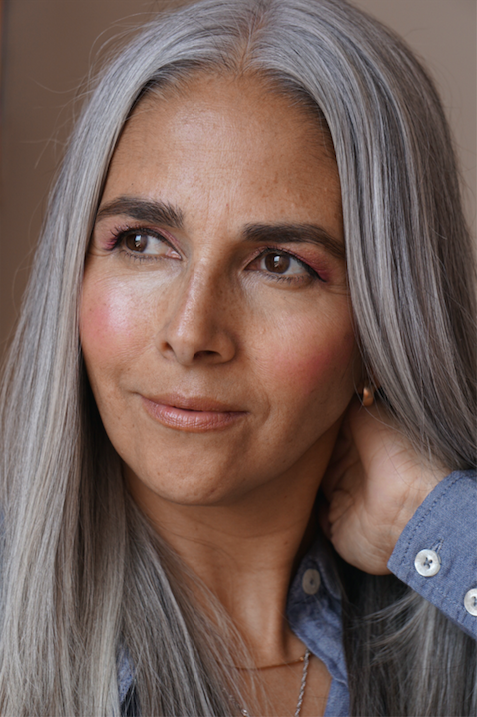
I started seeing my first grays at 14, I would pull them out and my mom would say that for every gray I pulled out, three would come to the funeral. I started coloring my hair at 19 until 2014. I was so tired of dyeing my hair every two to three weeks; my scalp would get irritated and the burning sensation would last a couple of days. My hair had no life, it was dull and it would not grow long. Now, I love my hair color, the texture, how healthy and long it is. I love that it makes me feel unique. I wear it so proudly. Before going gray, I looked average; now people pay me so many nice compliments. They approach me in the street and ask about my hair. Now, I stand out.
In Mexico, you see many women with gray hair but they are usually 60-plus. We are still just a few silver-haired women and when I started my transition, I saw disapproving faces everywhere. I’d get angry when I had to explain that we are programmed to think that gray hair is ugly, meant only for old women, or shows that you don’t care for your image. Going dye-free has helped me a lot; I feel real and true to myself.
To transition, you have to know it won’t be easy. But feeling your newly healthy hair grow gives you the courage and freedom to continue. In my case, I found an inner strength I never knew; my husband has been my biggest supporter and if he likes me like this then that’s what matters. Aging is a privilege. Stay active and healthy and if you feel young, that’s what you will show to the world.
Regina Burton, model, Germany
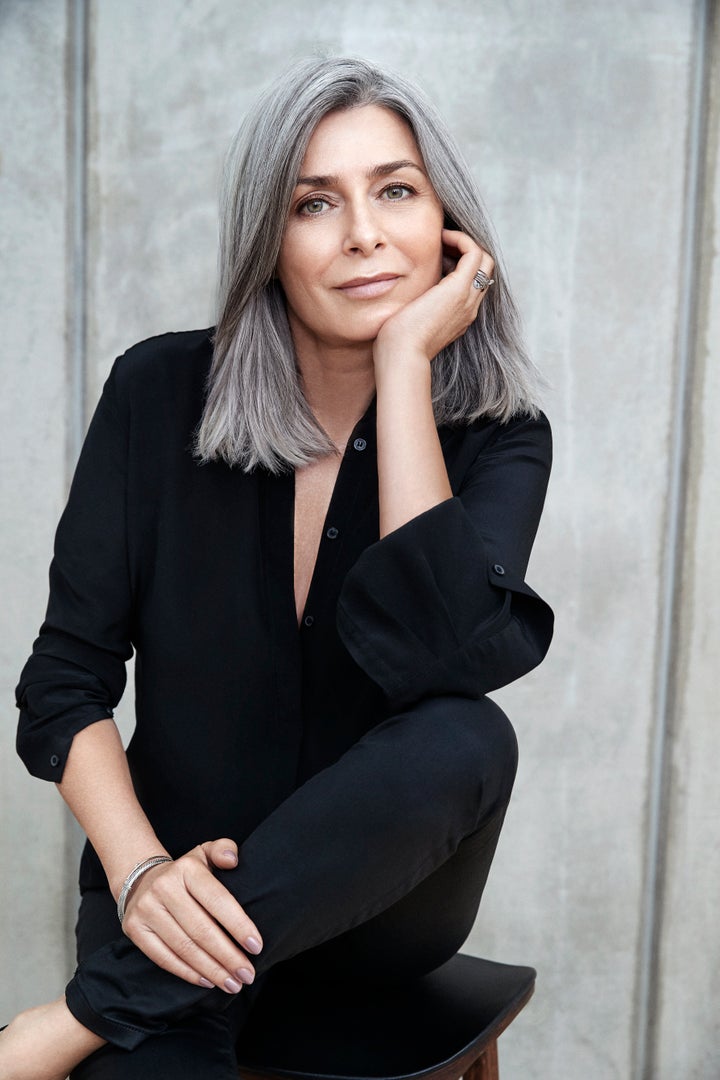
I have been dye-free since late 2017. Now my white and dark streaks are my trademark, because you could not dye it gray this way. That’s the beauty of being natural ― it’s not reproducible.
My decision came from seeing women and men over 70 with bleached blond or pitch-black hair ― they didn’t seem authentic. As a European, I learned early on that beauty comes in various forms. There isn’t a formula. Beauty is defined by special characteristics like inner strength, vitality and having conviction and charm. The idea was that you always have a choice; you can choose to highlight what you like about yourself.
I learned a lot about patience and believing in myself during the transitioning process, which was very tiring and tedious. I also learned that I can always start something new. After the transition was done, I embraced my transformation fully. I am growing into it more and more with every passing day, because I realize that I am a role model for other women, women of all ages.
I feel like I truly belong in this newly founded group of women who are really excited about their transition and happy about freeing themselves from peer pressure ― without feeling alone.
Karen Williams, producer and model, United States
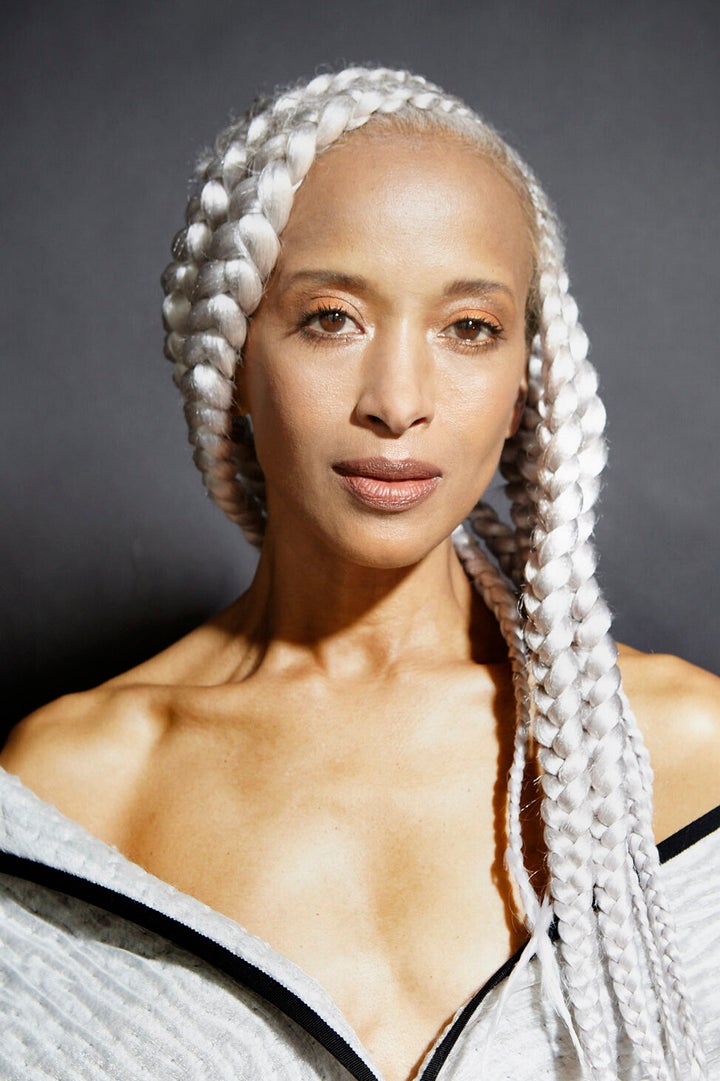
There’s nothing more empowering and liberating than being authentically, unapologetically me. And that’s what my silver hair is. I was about 17 when I spotted my first silver-gray strand. Since both my parents started graying around the same age, I was not at all surprised. As a beauty minimalist, I love the ease of living dye free. About every four years, I grow my hair down the middle of my back and then cut it really short, almost to the scalp. It’s the most exhilarating feeling. Only when it’s not there do you realize how distracting it can actually be and how conditioned women are to believe in the importance of hair.
In Caribbean cultures like most communities of color worldwide, living with, loving and admiring intergenerational family members is commonplace. Intimacy with older role models growing up normalizes aging and makes embracing and celebrating silver/gray hair a natural rite of passage. I’m inspired by my mum and my blood-related and non-kin aunties whom I’ve watched embrace every chapter of their lives with utmost ease and grace.
To me, self-awareness and a sense of purpose are precursors to joy. It really doesn’t matter what color your hair is. Joy comes from within so the work must be internal. Figure out who you are, what you truly value, what’s your unique purpose, what gives you inner peace, and don’t compare yourself to others. I would caution women, especially women of color, against buying into the manufactured fear and shame about aging that is propagated by mainstream media and advertising. Instead, we need to counter by building our own narratives around aging, based on our lived experiences.
